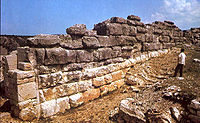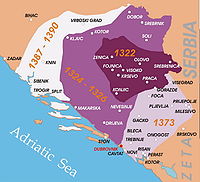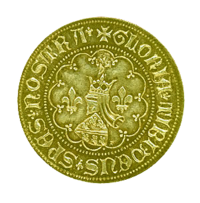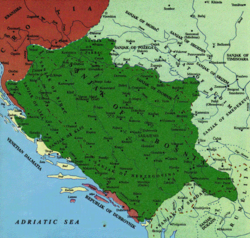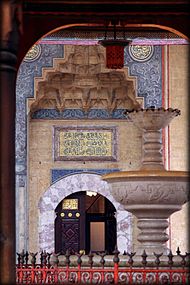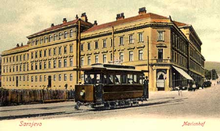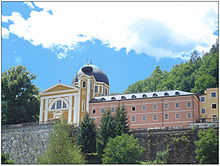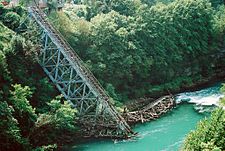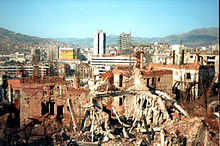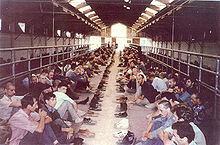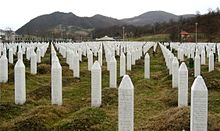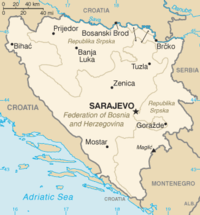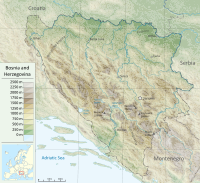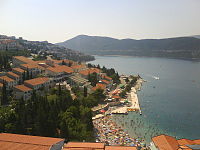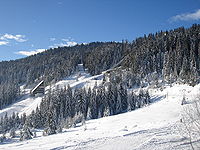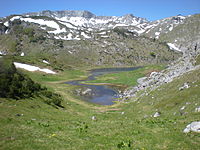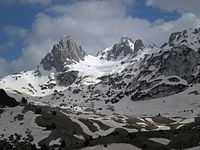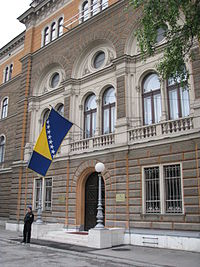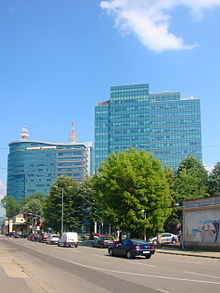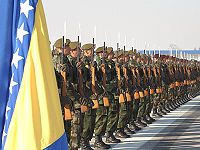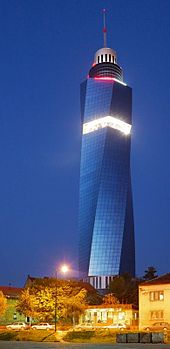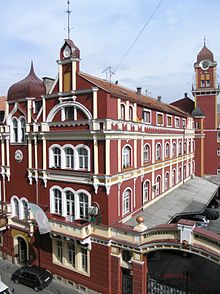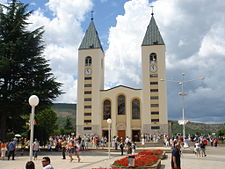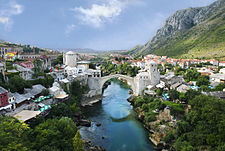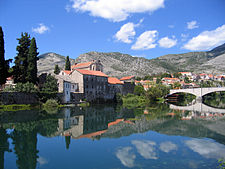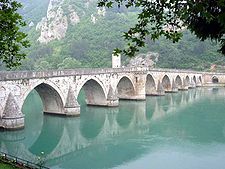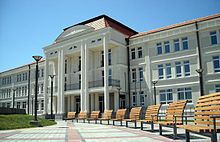
Bosnia and Herzegovina
Did you know...
This Schools selection was originally chosen by SOS Children for schools in the developing world without internet access. It is available as a intranet download. SOS Children works in 45 African countries; can you help a child in Africa?
| Bosnia and Herzegovina Bosna i Hercegovina
Босна и Херцеговина |
||||||
|---|---|---|---|---|---|---|
|
||||||
| Anthem: Državna himna Bosne i Hercegovine Државна химна Босне и Херцеговине National Anthem of Bosnia and Herzegovina |
||||||
|
Location of Bosnia and Herzegovina (green)
in Europe (dark grey) — [ Legend] |
||||||
| Capital and largest city |
Sarajevo 43°52′N 18°25′E |
|||||
| Official languages |
|
|||||
| Ethnic groups (2000) |
|
|||||
| Demonym |
|
|||||
| Government | Federal democratic republic | |||||
| - | High Representative | Valentin Inzkoa | ||||
| - | Presidency members |
|
||||
| - | Prime Minister | Vjekoslav Bevanda | ||||
| Legislature | Parliamentary Assembly | |||||
| - | Upper house | House of Peoples | ||||
| - | Lower house | House of Representatives | ||||
| Independence | ||||||
| - | First mentioned | 753 / 950 | ||||
| - | Banate of Bosnia | 1154 | ||||
| - | Kingdom of Bosnia | 1377 | ||||
| - | Conquered by Ottoman Empire | 1463 | ||||
| - | Bosnian uprising | 1831 | ||||
| - | Jurisdiction transferred to Austria–Hungary | 1878 | ||||
| - | Annexation of Bosnia by Austria-Hungary | 1908 | ||||
| - | National Day | 25 November 1943 | ||||
| - | Independence from SFR Yugoslavia | 1 March 1992 | ||||
| - | Observed | 6 April 1992 | ||||
| Area | ||||||
| - | Total | 51,197 km2 ( 127th) 19,741 sq mi |
||||
| Population | ||||||
| - | 2011 estimate | |||||
| - | 1991 census | 4,377,033 | ||||
| - | Density | 75/km2 ( 130the) 194/sq mi |
||||
| GDP ( PPP) | 2011 estimate | |||||
| - | Total | $31.638 billion | ||||
| - | Per capita | $8,133 | ||||
| GDP (nominal) | 2011 estimate | |||||
| - | Total | $17.965 billion | ||||
| - | Per capita | $4,618 | ||||
| Gini (2007) | 34.1 medium |
|||||
| HDI (2013) | high · 81st |
|||||
| Currency | Convertible mark ( BAM) |
|||||
| Time zone | CET ( UTC+1) | |||||
| - | Summer ( DST) | CEST ( UTC+2) | ||||
| Date format | dd.mm.yyyy ( CE) | |||||
| Drives on the | right | |||||
| Calling code | 387 | |||||
| ISO 3166 code | BA | |||||
| Internet TLD | .ba | |||||
| a. | Not a government member; the High Representative is an international civilian overseer of the Dayton peace agreement with authority to dismiss elected and non-elected officials and enact legislation. | |||||
| b. | Chair of current presidency ( Serb). | |||||
| c. | Current presidency member ( Croat). | |||||
| d. | Current presidency member ( Bosniak). | |||||
| e. | Rank based on 2011 official estimate of de facto population. | |||||
Bosnia and Herzegovina ( / ˈ b ɒ z n i ə ən h ɛ r t s ə ɡ oʊ ˈ v iː n ə /; Bosnian and Croatian: Bosna i Hercegovina, Serbian: Босна и Херцеговина), sometimes called Bosnia-Herzegovina or simply Bosnia, is a country in Southeastern Europe, on the Balkan Peninsula. Its capital and largest city is Sarajevo with an estimated urban population of 430,000 people. Bordered by Croatia to the north, west and south, Serbia to the east, and Montenegro to the southeast, Bosnia and Herzegovina is almost landlocked, except for the 20 kilometres (12 miles) of coastline on the Adriatic Sea surrounding the city of Neum. In the central and southern interior of the country the geography is mountainous, in the northwest it is moderately hilly, and the northeast is predominantly flatland. The inland is a geographically larger region and has a moderate continental climate, bookended by hot summers and cold and snowy winters. The southern tip of the country has a Mediterranean climate and plain topography.
Bosnia and Herzegovina is a region that traces permanent human settlement back to the Neolithic age, during and after which it was populated by several Illyrian and Celtic civilizations. Culturally, politically, and socially, the country has one of the richest histories in the region, having been first settled by the Slavic peoples that populate the area today from the 6th through to the 9th centuries AD. They then established the first independent banate in the region, known as the Banate of Bosnia, in the early 12th century upon the arrival and convergence of peoples that would eventually come to call themselves Dobri Bošnjani ("Good Bosnians"). This evolved into the Kingdom of Bosnia in the 14th century, after which it was annexed into the Ottoman Empire, under whose rule it would remain from the mid 15th to the late 19th centuries. The Ottomans brought Islam to the region, and altered much of the cultural and social outlook of the country. This was followed by annexation into the Austro-Hungarian Monarchy, which lasted up until World War I. In the interwar period, the country became part of the Kingdom of Serbs, Croats and Slovenes - later renamed Yugoslavia. After World War II, the country was granted full republic status in a newly formed Yugoslav Federation. Following the dissolution of the Socialist Federal Republic of Yugoslavia, the country proclaimed independence in 1992, which was followed by the Bosnian War, lasting until late 1995.
Today, the country maintains high literacy, life expectancy and education levels and is one of the most frequently-visited countries in the region. Bosnia and Herzegovina is regionally and internationally renowned for its natural beauty and cultural heritage inherited from six historical civilizations, its cuisine, winter sports, its eclectic and unique music, architecture and the Sarajevo Film Festival and Sarajevo Jazz Festival, both the largest and most prominent of their kind in Southeastern Europe.
The country is home to three ethnic groups or, officially, constituent peoples, a term unique for Bosnia and Herzegovina. Bosniaks are the largest group of the three, with Serbs second and Croats third. Regardless of ethnicity, a citizen of Bosnia and Herzegovina is often identified in English as a Bosnian. The terms Herzegovinian and Bosnian are maintained as a regional rather than ethnic distinction, and the region of Herzegovina has no precisely defined borders of its own. Moreover, the country was simply called "Bosnia" until the Austro-Hungarian occupation at the end of the nineteenth century.
Bosnia and Herzegovina has a bicameral legislature and a three-member Presidency composed of a member of each major ethnic group. However, the central government's power is highly limited, as the country is largely decentralized and comprises two autonomous entities: the Federation of Bosnia and Herzegovina and Republika Srpska, with a third region, the Brčko District, governed under local government. The Federation of Bosnia and Herzegovina is itself complex and consists of 10 federal units - cantons. The country is a potential candidate for membership to the European Union and has been a candidate for NATO membership since April 2010, when it received a Membership Action Plan at the summit in Tallinn. Additionally, the country has been a member of the Council of Europe since April 2002 and a founding member of the Mediterranean Union upon its establishment in July 2008.
Etymology
The first preserved mention of the name "Bosnia" is in De Administrando Imperio, a politico-geographical handbook written by the Byzantine emperor Constantine VII in the mid-10th century (between 948 and 952) describing the "small country" (χωρίον in Greek) of "Bosona" (Βοσώνα). The Chronicle of the Priest of Duklja from 1172-1196 of Bar's Roman Catholic Christian Archbishop names Bosnia, and references an earlier source from the year of 753 - the De Regno Sclavorum (Of the Realm of Slavs). The name "Bosnia" probably comes from the name of the Bosna river around which it has been historically based, which was recorded in the Roman era under the name Bossina. More direct roots of the river's names are unknown. Philologist Anton Mayer proposed a connection with the Indo-European root *bos or *bogh, meaning "running water". Certain Roman sources similarly mention Bathinus flumen as a name of the Illyrian Bosona, both of which would mean "running water" as well. Other theories involve the rare Latin term Bosina, meaning boundary, and possible Slavic origins.
The origins of the name Herzegovina may be identified with greater precision. In the Early Middle Ages the corresponding region was known as Zahumlje (Hum), after the Zachlumoi tribe of southern Slavs which inhabited it. In the 1440s, the region - adjoined to medieval Bosnia since the early 1300s - was ruled by the powerful Bosnian nobleman Stephen Vukčić Kosača. In a document sent to Friedrich III on 20 January 1448, Stefan Vukčić Kosača styled himself "Herzog of Saint Sava, Lord of Hum and Primorje, Grand Duke of Bosnia"; Herzog being the German word for " duke", and so the lands he controlled would later be known as Herzegovina ("Dukedom", from the addition of -ovina, "land"). The region was administered by the Ottomans as the Sanjak of Herzegovina (Hersek) within the Eyalet of Bosnia, until its own brief elevation into the Herzegovina Eyalet in the 1830s. Following the death of Herzegovinian ruler vizier Ali-paša Rizvanbegović in the 1850s, the eyalets of Bosnia and Herzegovina were merged, and the new joint-entity was thereafter commonly referred to as Bosnia and Herzegovina.
On initial proclamation of independence in 1992 the country's official name was the Republic of Bosnia and Herzegovina but following the 1995 Dayton Agreement and the new constitution that accompanied it the name was officially changed to Bosnia and Herzegovina.
History
Early history
Bosnia has been inhabited since at latest the Neolithic age. The earliest Neolithic population became known in the Antiquity as the Illyrians. Celtic migrations in the 4th century BC were also notable. Concrete historical evidence for this period is scarce, but overall it appears that the region was populated by a number of different peoples speaking distinct languages. Conflict between the Illyrians and Romans started in 229 BC, but Rome did not complete its annexation of the region until AD 9.
It was precisely in what is now Bosnia and Herzegovina that Rome fought one of the most difficult battles in its history since the Punic Wars, as described by the Roman historian Suetonius. This was the Roman campaign against the revolt of indigenous communities from Illyricum, known in history as the Great Illyrian Revolt, and also as the Pannonian revolt, or Bellum Batonianum, the latter named after two leaders of the rebellious Illyrian communities, Bato of the Daesitiates, and Bato of the Breuci.
The Great Illyrian revolt was a rising up of Illyrians against the Romans, more specifically a revolt against Tiberius' attempt to recruit them for his war against the Germans. The Illyrians put up a fierce resistance to the most powerful army on earth at the time (the Roman Army) for four years (AD 6 to AD 9), but they were finally subdued by Rome in AD 9.
The last Illyrian stronghold, of which their defence won the admiration of Roman historians, is said to have been Arduba. Bato of Daesitiates was captured and taken to Italy. It is alleged that when Tiberius asked Bato and the Daesitiates why they had rebelled, Baton was reputed to have answered: "You Romans are to blame for this; for you send as guardians of your flocks, not dogs or shepherds, but wolves." Bato spent the rest of his life in the Italian town of Ravenna.
In the Roman period, Latin-speaking settlers from the entire Roman Empire settled among the Illyrians, and Roman soldiers were encouraged to retire in the region.
The land was originally part of Illyria up until the Roman occupation. Following the split of the Roman Empire between 337 and 395 AD, Dalmatia and Pannonia became parts of the Western Roman Empire. Some claim that the region was conquered by the Ostrogoths in 455 AD. It subsequently changed hands between the Alans and the Huns. By the 6th century, Emperor Justinian had reconquered the area for the Byzantine Empire. The Illyrians were conquered by the Avars in the 6th century.
However, the Illyrians did not entirely vanish from Bosnia and Herzegovina with the arrival of new cultures. A large part of the remaining Illyrian culture intermingled with those of new settlers, some of it is believed to have been adopted by the latter, and some survived up to date, such as architectural remains (e.g. Daorson near Stolac), certain customs and traditions (e.g.tatooing, the 'gluha kola' dances, the 'ganga' singing, zig-zag and concentric circles in traditional decorations), place names (e.g. Čapljina, from 'čaplja', a south Slavic word for 'heron', coincides with 'Ardea', a Latin word for 'heron', and 'Ardea', in turn, bears striking similarity with the name of Ardiaei, the native Illyrian people of the wider Neretva valley region, where the town of Čapljina is situated), etc.
Medieval Bosnia
Modern knowledge of the political situation in the west Balkans into the region in the late 9th century is scarce. The Slavic tribes also brought their mythology and pagan system of beliefs, the Rodovjerje. In particular, Perun / Перун, the highest god of the pantheon and the god of thunder and lightning is also commonly found in Bosnian toponymy, for instance in the name of Mount Perun (Perunova Gora / Перунова Гора). Along with the Slavic settlers, the native Illyrians were Christianized. Bosnia and Herzegovina, because of its geographic position and terrain, was probably one of the last areas to go through this process, which presumably originated from the urban centers along the Dalmatian coast. Thus, Slavic Bosnian tribes remained pagans for a longer time, and finally converted to Christianity.
The principalities of Serbia and Croatia split control of Bosnia and Herzegovina in the 9th and 10th century, but by the High Middle Ages political circumstance led to the area being contested between the Kingdom of Hungary and the Byzantine Empire. Following another shift of power between the two in the early 12th century, Bosnia found itself outside the control of both and emerged as an independent state under the rule of local bans.
The first Bosnian monarch was Ban Borić. The second was Ban Kulin whose rule marked the start of a controversy with the Bosnian Church, because he allowed an indigenous Bogomilism sect considered heretical by the Roman Catholic Church. In response to Hungarian attempts to use church politics regarding the issue as a way to reclaim sovereignty over Bosnia, Kulin held a council of local church leaders to renounce the heresy and embraced Catholicism in 1203. Despite this, Hungarian ambitions remained unchanged long after Kulin's death in 1204, waning only after an unsuccessful invasion in 1254.
Bosnian history from then until the early 14th century was marked by a power struggle between the Šubić and Kotromanić families. This conflict came to an end in 1322, when Stephen II Kotromanić became Ban. By the time of his death in 1353, he was successful in annexing territories to the north and west, as well as Zahumlje and parts of Dalmatia. He was succeeded by his ambitious nephew Tvrtko who, following a prolonged struggle with nobility and inter-family strife, gained full control of the country in 1367. By the year 1377, Bosnia was elevated into a kingdom with the coronation of Tvrtko as the first Bosnian King in Mile near Visoko in the Bosnian heartland.
Following his death in 1391 however, Bosnia fell into a long period of decline. The Ottoman Empire had already started its conquest of Europe and posed a major threat to the Balkans throughout the first half of the 15th century. Finally, after decades of political and social instability, the Kingdom of Bosnia ceased to exist in 1463 after its conquest by the Ottoman empire.
Ottoman Era (1463–1878)

The Ottoman conquest of Bosnia marked a new era in the country's history and introduced drastic changes in the political and cultural landscape. The Ottomans allowed for the preservation of Bosnia's identity by incorporating it as an integral province of the Ottoman Empire with its historical name and territorial integrity — a unique case among subjugated states in the Balkans.
Within Bosnia the Ottomans introduced a number of key changes in the territory's socio-political administration; including a new landholding system, a reorganization of administrative units, and a complex system of social differentiation by class and religious affiliation.
The three centuries of Ottoman rule also had a drastic impact on Bosnia's population make-up, which changed several times as a result of the empire's conquests, frequent wars with European powers, forced and economic migrations, and epidemics. A native Slavic-speaking Muslim community emerged and eventually became the largest of the ethno-religious groups due to lack of strong Christian church organizations and continuous rivalry between orthodox and catholic churches.
The Bosnian Christian communities also experienced major changes. The Bosnian Franciscans (and the Catholic population as a whole) were to a minor extent protected by official imperial decree, while the Bosnian Church disappeared altogether.
As the Ottoman Empire continued their rule in the Balkans ( Rumelia), Bosnia was somewhat relieved of the pressures of being a frontier province, and experienced a period of general welfare. A number of cities, such as Sarajevo and Mostar, were established and grew into regional centers of trade and urban culture and were then visited by Ottoman traveler Evliya Çelebi in 1648. Within these cities, various Ottoman Sultans financed the construction of many works of Bosnian architecture such as the country's first library in Sarajevo, madrassas, a school of Sufi philosophy, and a clock tower (Sahat Kula), bridges such as the Stari Most, the Tsar's Mosque and the Gazi Husrev-beg's Mosque.
Furthermore, some Bosnians played influential roles in the Ottoman Empire's cultural and political history during this time. Bosnian recruits formed a large component of the Ottoman ranks in the battles of Mohács and Krbava field, while numerous other Bosnians rose through the ranks of the Ottoman military to occupy the highest positions of power in the Empire, including admirals such as Matrakçı Nasuh; generals such as Isa-Beg Isaković, Gazi Husrev-beg and Hasan Predojević and Sarı Süleyman Paşa; administrators such as Ferhat-paša Sokolović and Osman Gradaščević; and Grand Viziers such as the influential Mehmed Paša Sokolović and Damad Ibrahim Pasha. Some Bosnians emerged as Sufi mystics, scholars such as Muhamed Hevaji Uskufi Bosnevi, Ali Džabič; and poets in the Turkish, Albanian, Arabic, and Persian languages.
However, by the late 17th century the Empire's military misfortunes caught up with the country, and the conclusion of the Great Turkish War with the treaty of Karlowitz in 1699 once again made Bosnia the Empire's westernmost province. The following century was marked by further military failures, numerous revolts within Bosnia, and several outbursts of plague. The Porte's false efforts at modernizing the Ottoman state were met with distrust growing to hostility in Bosnia, where local aristocrats stood to lose much through the proposed reforms.
This, combined with frustrations over territorial, political concessions in the north-east, and the plight of Slavic Muslim refugees arriving from the Sanjak of Smederevo into Bosnia Eyalet, culminated in a partially unsuccessful revolt by Husein Gradaščević, who endorsed a multicultural Bosnia Eyalet autonomous from the authoritarian rule of the Ottoman Sultan Mahmud II, who persecuted, executed and abolished the Janissary and reduced the role of autonomous Pasha's in Rumelia. Mahmud II sent his Grand Vizier to subdue Bosnia Eyalet and succeeded only with the reluctant assistance of Ali-paša Rizvanbegović. Related rebellions would be extinguished by 1850, but the situation continued to deteriorate. Later agrarian unrest eventually sparked the Herzegovinian rebellion, a widespread peasant uprising, in 1875. The conflict rapidly spread and came to involve several Balkan states and Great Powers, a situation which eventually led to the Congress of Berlin and the Treaty of Berlin in 1878.
Austro-Hungarian rule (1878–1918)
At the Congress of Berlin in 1878, the Austro-Hungarian Foreign Minister Gyula Andrássy obtained the occupation and administration of Bosnia and Herzegovina, and he also obtained the right to station garrisons in the Sanjak of Novi Pazar, which remained under Ottoman administration. The Sanjak preserved the separation of Serbia and Montenegro, and the Austro-Hungarian garrisons there would open the way for a dash to Salonika that "would bring the western half of the Balkans under permanent Austrian influence." "High [Austro-Hungarian] military authorities desired [an...] immediate major expedition with Salonika as its objective."
On 28 September 1878 the Finance Minister, Koloman von Zell, threatened to resign if the army, backed by the Archduke Albert, were allowed to advance to Salonika. In the session of the Hungarian Parliament of 5 November 1878 the Opposition proposed that the Foreign Minister should be impeached for violating the constitution with his policy during the Near East Crisis and by the occupation of Bosnia-Herzegovina. The motion lost 179 to 95. The gravest accusations were raised by the opposition rank and file against Andrassy.
Although an Austro-Hungarian side quickly came to an agreement with Bosnians, tensions remained in certain parts of the country (particularly the south) and a mass emigration of predominantly Slavic dissidents occurred. However, a state of relative stability was reached soon enough and Austro-Hungarian authorities were able to embark on a number of social and administrative reforms which intended to make Bosnia and Herzegovina into a "model colony".
With the aim of establishing the province as a stable political model that would help dissipate rising South Slav nationalism, Habsburg rule did much to codify laws, to introduce new political practices, and to provide for modernisation. The Austro-Hungarian Empire built the three Roman Catholic churches in Sarajevo and these three churches are among only 20 Catholic churches in the state of Bosnia.
Within three years of formal occupation of Bosnia Herzegovina, Austria-Hungary, in 1881, obtained German, and more importantly, Russian, approval for the annexation of these provinces, at a time which suited Vienna. This mandate was formally ratified by the Dreikaiserbund (Three Emperor's Treaty) on June 18 of that year. Upon the accession of Czar Nicholas II, however, the Russians reneged on the agreement, asserting in 1897 the need for special scrutiny of the Bosnian Annexation issue at an unspecified future date.
External matters began to affect the Bosnian Protectorate, however, and its relationship with Austria-Hungary. A bloody coup occurred in Serbia, on June 10, 1903, which brought a radical anti-Austrian government into power in Belgrade. Serb attempts to foment agitation followed, advocating a unified South Slavic state, ruled from Belgrade. This gained little support among most of the population of Bosnia Herzegovina, and only found fertile ground with disaffected portions of the Orthodox minority. Also, the revolt in the Ottoman Empire in 1908, raised concerns that the Istanbul government might seek the outright return of Bosnia Herzegovina. These factors caused the Austrian-Hungarian government to seek a permanent resolution of the Bosnian question, sooner, rather than later.
On July 2, 1908, in response to the pressing of the Austrian-Hungarian claim, the Russian Imperial Foreign Minister Alexander Izvolsky offered to support the Bosnian Annexation in return for Vienna's support for Russia's bid for naval access through the Dardanelles Straits into the Mediterranean. With the Russians being, at least, provisionally willing to keep their word over Bosnia Herzegovina for the first time in 11 years, Austria-Hungary waited and then published the annexation proclamation on October 6, 1908. The international furor over the annexation announcement caused Izvolsky to drop the Dardanelles Straits question, altogether, in an effort to obtain a European conference over the Bosnian Annexation. This conference never materialized and without British or French support, the Russians and their client state, Serbia, were compelled to accept the Austrian-Hungarian annexation of Bosnia Herzegovina in March 1909.
Political tensions culminated on 28 June 1914, when a Yugoslav nationalist youth Gavrilo Princip, a member of the Yugoslav movement, Young Bosnia, assassinated the heir to the Austro-Hungarian throne, Archduke Franz Ferdinand, in Sarajevo – an event that proved to be the spark that set off World War I. Although some Bosnians died serving in the armies of the various warring states, Bosnia and Herzegovina itself managed to escape the conflict relatively unscathed.
Kingdom of Yugoslavia (1918–1941)
Following the war, Bosnia and Herzegovina joined the South Slav Kingdom of Serbs, Croats and Slovenes (soon renamed Yugoslavia). Political life in Bosnia at this time was marked by two major trends: social and economic unrest over property redistribution, and formation of several political parties that frequently changed coalitions and alliances with parties in other Yugoslav regions. The dominant ideological conflict of the Yugoslav state, between Croatian regionalism and Serbian centralization, was approached differently by Bosnia's major ethnic groups and was dependent on the overall political atmosphere. The political reforms brought about in the newly established Yugoslavian kingdom saw few benefits for the Bosniaks; according to the 1910 final census of land ownership and population according to religious affiliation conducted in Austro-Hungary, Muslims (Bosniaks) owned 91.1%, Orthodox Serbians owned 6.0%, Croatian Catholics owned 2.6% and others, 0.3% of the property. Following the reforms Bosnian Muslims had a total of 1,175,305 hectares of agricultural and forest land taken away from them.
Although the initial split of the country into 33 oblasts erased the presence of traditional geographic entities from the map, the efforts of Bosnian politicians such as Mehmed Spaho ensured that the six oblasts carved up from Bosnia and Herzegovina corresponded to the six sanjaks from Ottoman times and, thus, matched the country's traditional boundary as a whole.
The establishment of the Kingdom of Yugoslavia in 1929, however, brought the redrawing of administrative regions into banates or banovinas that purposely avoided all historical and ethnic lines, removing any trace of a Bosnian entity. Serbo-Croat tensions over the structuring of the Yugoslav state continued, with the concept of a separate Bosnian division receiving little or no consideration.
The Cvetković-Maček Agreement that created the Croatian banate in 1939 encouraged what was essentially a partition of Bosnia between Croatia and Serbia. However the rising threat of Adolf Hitler's Nazi Germany forced Yugoslav politicians to shift their attention. Following a period that saw attempts at appeasement, the signing of the Tripartite Treaty, and a coup d'état, Yugoslavia was finally invaded by Germany on 6 April 1941.
World War II (1941–45)
Once the kingdom of Yugoslavia was conquered by Nazi forces in World War II, all of Bosnia was ceded to the Nazi puppet regime, Independent State of Croatia. The Croat leaders embarked on a campaign of extermination of Serbs, Jews, Roma, Croats who opposed the regime, communists and large numbers of Josip Broz Tito's Partisans by setting up a number of death camps. The Ustaše recognized both Roman Catholicism and Islam as the national religions, but held the position that Eastern Orthodoxy, as a symbol of Serbian identity, was their greatest foe. Between 197,000 and 580,000 Serbs were killed. According to the United States Holocaust Museum, 320,000-340,000 ethnic Serbs were murdered by the Ustaše during the Second World War.
Many Serbs themselves took up arms and joined the Chetniks, a Serb nationalist movement that conducted operations against the Nazi forces and the partisans. The Chetniks were also known to persecute and murder non-Serbs and communist sympathizers. On October 12, 1941 a group of 108 notable Muslim citizens of Sarajevo signed the Resolution of Sarajevo Muslims by which they condemned the persecution of Serbs organized by Ustaše, made distinction between Muslims who participated in such persecutions and whole Muslim population, presented informations about the persecutions of Muslims by Serbs and requested security for all citizens of the country, regardless of their identity. Later, many Bosnian Muslims served in the Waffen-SS units.
Starting in 1941, Yugoslav communists under the leadership of Josip Broz Tito organized their own multi-ethnic resistance group, the partisans, who fought against both Axis and Chetnik forces. On 29 November 1943 the Anti-Fascist Council of National Liberation of Yugoslavia with Tito at its helm held a founding conference in Jajce where Bosnia and Herzegovina was reestablished as a republic within the Yugoslavian federation in its Habsburg borders.
Military success eventually prompted the Allies to support the Partisans, but Tito declined their offer to help and relied on his own forces instead. All the major military offensives by the antifascist movement of Yugoslavia against Nazis and their local supporters were conducted in Bosnia-Herzegovina and its peoples bore the brunt of fighting. More than 300,000 people died in Bosnia and Herzegovina in World War II. At the end of the war the establishment of the Socialist Federal Republic of Yugoslavia, with the constitution of 1946, officially made Bosnia and Herzegovina one of six constituent republics in the new state.
Socialist Yugoslavia (1945–1992)
Due to its central geographic position within the Yugoslavian federation, post-war Bosnia was selected as a base for the development of the military defense industry. This contributed to a large concentration of arms and military personnel in Bosnia; a significant factor in the war that followed the break-up of Yugoslavia in the 1990s. However, Bosnia's existence within Yugoslavia, for the large part, was peaceful and prosperous. Though considered a political backwater of the federation for much of the 1950s and 1960s, in the 1970s a strong Bosnian political elite arose, fueled in part by Tito's leadership in the Non-Aligned Movement and Bosnians serving in Yugoslavia's diplomatic corps.
While working within the communist system, politicians such as Džemal Bijedić, Branko Mikulić and Hamdija Pozderac reinforced and protected the sovereignty of Bosnia and Herzegovina Their efforts proved key during the turbulent period following Tito's death in 1980, and are today considered some of the early steps towards Bosnian independence. However, the republic did not escape the increasingly nationalistic climate of the time. With the fall of the Soviet Union and the start of the break-up of Yugoslavia, the old communist doctrine of tolerance began to lose its potency, creating an opportunity for nationalist elements in the society to spread their influence.
Bosnian War for independence (1992–1995)

On 18 November 1990, the first multi-party parliamentary elections were held. A second round followed on 25 November, resulting in a national assembly where communist power was replaced by a coalition of three ethnically based parties. Croatia and Slovenia's subsequent declarations of independence and the warfare that ensued placed Bosnia and Herzegovina and its three constituent peoples in an awkward position. A significant split soon developed on the issue of whether to stay with the Yugoslav federation (overwhelmingly favored among Serbs) or seek independence (overwhelmingly favored among Bosniaks and Croats).
The Serb members of parliament, consisting mainly of the Serb Democratic Party members, abandoned the central parliament in Sarajevo, and formed the Assembly of the Serb People of Bosnia and Herzegovina on 24 October 1991, which marked the end of the tri-ethnic coalition that governed after the elections in 1990. This Assembly established the Serbian Republic of Bosnia and Herzegovina on 9 January 1992, which became Republika Srpska in August 1992.
On 18 November 1991, the party branch in Bosnia and Herzegovina of the ruling party in the Republic of Croatia, the Croatian Democratic Union (HDZ), proclaimed the existence of the Croatian Community of Herzeg-Bosnia, as a separate "political, cultural, economic, and territorial whole", on the territory of Bosnia and Herzegovina, with Croat Defence Council (HVO) as its military part. The Bosnian government did not recognize it. The Constitutional Court of Bosnia and Herzegovina declared Herzeg-Bosnia illegal, first on 14 September 1992 and again on 20 January 1994.
A declaration of Bosnia and Herzegovina sovereignty on 15 October 1991 was followed by a referendum for independence from Yugoslavia on 29 February and 1 March 1992 boycotted by the great majority of the Serbs. The turnout in the independence referendum was 63.4 percent and 99.7 percent of voters voted for independence. Bosnia and Herzegovina declared independence on 3 March 1992. Following a tense period of escalating tensions the opening shots in the incipient Bosnian conflict were fired when Serb paramilitary forces attacked Bosnian Croat villages around Capljina on 7 March 1992 and around Bosanski Brod and Bosniak town, Gorazde, on 15 March. These minor attacks were followed by much more serious Serb artillery attacks on Neum on 19 March and on Bosanski Brod on 24 March. It is disputed between Bosniaks, Croats and Serbs who the first casualties of the war are. Bosniaks regard the killing of Suada Dilberović, a Bosniak civilian woman shot dead by a sniper in April 1992, as marking the start of warfare between the three major communities. Serbs consider an attack by Bosniaks on a Serb wedding procession and the killing of Nikola Gardović, the groom's father, on 1 March 1992 in Sarajevo's old town Baščaršija, to be the catalyst for the war.
Secret discussions between Franjo Tuđman and Slobodan Milošević on the division of Bosnia and Herzegovina between Serbia and Croatia were held as early as March 1991, known as the Karađorđevo agreement. Following the declaration of independence of the Republic of Bosnia and Herzegovina, the Serbs attacked different parts of the country. The state administration of Bosnia and Herzegovina effectively ceased to function having lost control over the entire territory. The Serbs wanted control and possession of virtually all territories in Bosnia and Herzegovina, as a top priority of Milošević's mastermind plan of a "Greater Serbia".
The Croats and their leader Tuđman also aimed at securing the remaining parts of Bosnia and Herzegovina as exclusively Croatian. The policies of the Republic of Croatia and its leader Franjo Tuđman towards Bosnia and Herzegovina were never totally transparent and always included Franjo Tuđman's ultimate aim of expanding Croatia's borders. Bosnian Muslims were an easy target, because the Bosnian government forces were poorly equipped and unprepared for the war.
International recognition of Bosnia and Herzegovina increased diplomatic pressure for the Yugoslav People's Army (JNA) to withdraw from the republic's territory which they officially did. However, in fact, the Bosnian Serb members of JNA simply changed insignia, formed the Army of Republika Srpska, and continued fighting. Armed and equipped from JNA stockpiles in Bosnia, supported by volunteers and various paramilitary forces from Serbia, and receiving extensive humanitarian, logistical and financial support from the Federal Republic of Yugoslavia, Republika Srpska's offensives in 1992 managed to place much of the country under its control.
Initially, the Serb forces attacked the non-Serb civilian population in Eastern Bosnia. Once towns and villages were securely in their hands, the Serb forces—military, police, the paramilitaries and, sometimes, even Serb villagers—applied the same pattern: Bosniak houses and apartments were systematically ransacked or burnt down, Bosniak civilians were rounded up or captured, and sometimes beaten or killed in the process. 2.2 million refugees were displaced by the end of the war (of all three nationalities).
Able-bodied men were separated from their families and interned in camps under a brutal regimen of abuse, murder, and sporadic group executions, whereas women and children were kept in unsanitary detention centers, deprived of food and water. Rape by Serb soldiers or policemen was commonplace at the detention centers, and victims included women and minors as young as 12 years old.
Though on a significantly smaller scale, war crimes would later also be committed by Bosniaks and Croats as their military campaigns gained momentum, including the establishment of prison camps in which torture, murder and rape took place.
In June 1992, the focus switched to Novi Travnik and Gornji Vakuf where the Croat Defence Council (HVO) efforts to gain control were resisted. On 18 June 1992 the Bosnian Territorial Defence in Novi Travnik received an ultimatum from the HVO which included demands to abolish existing Bosnia and Herzegovina institutions, establish the authority of the Croatian Community of Herzeg-Bosnia and pledge allegiance to it, subordinate the Territorial Defense to the HVO and expel Muslim refugees, all within 24 hours. The attack was launched on June 19. The elementary school and the Post Office were attacked and damaged.
Gornji Vakuf was initially attacked by Croats on 20 June 1992, but the attack failed. The Graz agreement caused deep division inside the Croat community and strengthened the separation group, which led to the conflict with Bosniaks. One of the primary pro-union Croat leaders, Blaž Kraljević (leader of the Croatian Defence Forces (HOS) armed group) was killed by HVO soldiers in August 1992, which severely weakened the moderate group who hoped to keep the Bosnian Croat alliance alive.
The situation became more serious in October 1992 when Croat forces attacked the Bosniak population in Prozor. According to Jadranko Prlić indictment, HVO forces cleansed most of the Muslims from the town of Prozor and several surrounding villages.
By 1993 when an armed conflict erupted between the predominantly Bosniak government in Sarajevo and the Croatian Republic of Herzeg-Bosnia, about 70% of the country was controlled by Republika Srpska. Ethnic cleansing and civil rights violations against non-Serbs were rampant in these areas. DNA teams have been used to collect evidence of the atrocities committed by Serbian forces during these campaigns. The single most prominent example was the Srebrenica massacre, ruled a genocide by the International Criminal Tribunal for the former Yugoslavia. An estimated 8,372 Bosnians were killed by the Serbian political authorities.
In March 1994, the signing of the Washington Accords between the leaders of the republican government and Herzeg-Bosnia led to the creation of a joint Bosniak-Croat Federation of Bosnia and Herzegovina, which absorbed the territory of the Croatian Republic of Herzeg-Bosnia and that held by the Army of the Republic of Bosnia and Herzegovina. The Federation soon liberated the small Autonomous Province of Western Bosnia.
Following the Srebrenica massacre, a NATO bombing campaign began in August 1995 against the Army of Republika Srpska. Meanwhile, a ground offensive by the allied forces of Croatia and Bosnia, based on the Split Agreement signed by Tudjman and Izetbegović, pushed the Serbs away from territories held in western Bosnia which paved the way to negotiations. In December 1995, the signing of the Dayton Agreement in Dayton, Ohio, by the presidents of Bosnia and Herzegovina ( Alija Izetbegović), Croatia ( Franjo Tuđman) and Serbia ( Slobodan Milošević) brought a halt to the fighting, roughly establishing the basic structure of the present-day state. A NATO-led peacekeeping force was immediately dispatched to Bosnia to enforce the agreement.
The number of identified victims is currently at 97,207 (civilian and military casualties). These include 64,341 Bosniaks, 24,726 Serbs, and 7,602 Croats. Recent research estimates the total number to be no more than 110,000 killed (civilians and military), and 1.8 million displaced. Those declared missing are being investigated by International Commission on Missing Persons.
According to numerous International Criminal Tribunal for the former Yugoslavia (ICTY) judgements, the conflict involved Bosnia and the Federal Republic of Yugoslavia (subsequently Serbia and Montenegro) as well as Croatia.
At the International Court of Justice (ICJ), the Bosnian government charged Serbia of complicity in genocide in Bosnia during the war. The ICJ ruling of 26 February 2007 effectively determined the war's nature to be international, though exonerating Serbia of direct responsibility for the genocide committed by Serb forces of Republika Srpska. The ICJ concluded, however, that Serbia failed to prevent genocide committed by Serb forces and failed to punish those who carried out the genocide – in particular General Ratko Mladić – and bring them to justice. Mladić was arrested in a village in northern Serbia on 26 May 2011 and, among other genocide and war crime charges, accused of directly orchestrating and overseeing the slaughter of 8,000 Muslim men and boys.
The judges ruled that the criteria for genocide with the specific intent ( dolus specialis) to destroy Bosnian Muslims were met only in Srebrenica or Eastern Bosnia in 1995. The court concluded that the crimes committed during the 1992–1995 war may, according to international law, amount to crimes against humanity, but that these acts did not in themselves constitute genocide. The Court further decided that Serbia was the only respondent party in the case after Montenegro's declaration of independence in June 2006, but that "any responsibility for past events involved, at the relevant time, the composite State of Serbia and Montenegro".
High-ranking Croat and Bosniak officials have been convicted or indicted for war crimes as well on charges related to the murder, rape, torture, and imprisonment of civilians. Serbs have accused Sarajevo authorities of practicing selective justice by actively prosecuting Serbs while ignoring or downplaying Bosniak war crimes.
Geography
Bosnia is located in the western Balkans, bordering Croatia (932 km/579 mi) to the north and south-west, Serbia (302 km/188 mi) to the east, and Montenegro (225 km/140 mi) to the southeast. It lies between latitudes 42° and 46° N, and longitudes 15° and 20° E.
The country's name comes from the two regions Bosnia and Herzegovina, which have a very vaguely defined border between them. Bosnia occupies the northern areas which are roughly four-fifths of the entire country, while Herzegovina occupies the rest in the south part of the country.
The country is mostly mountainous, encompassing the central Dinaric Alps. The northeastern parts reach into the Pannonian basin, while in the south it borders the Adriatic. Dinaric Alps generally run in east-west direction, and get higher towards the south. The highest point of the country is peak Maglić at 2,386 m, at the Montenegrin border. Major mountains include Kozara, Grmeč, Vlašić, Čvrsnica, Prenj, Romanija, Jahorina, Bjelašnica and Treskavica.
Overall, close to 50% of Bosnia and Herzegovina is forested. Most forest areas are in Central, Eastern and Western parts of Bosnia. Herzegovina has drier Mediterranean climate, with dominant karst topography. Northern Bosnia ( Posavina) contains very fertile agricultural land along the river Sava and the corresponding area is heavily farmed. This farmland is a part of the Parapannonian Plain stretching into neighboring Croatia and Serbia. The country has only 20 kilometers (12 mi) of coastline, around the town of Neum in the Herzegovina-Neretva Canton. Although the city is surrounded by Croatian peninsulas, by the international law, Bosnia and Herzegovina has a right of passage to the outer sea.
The major cities are the capital Sarajevo, Banja Luka in the northwest region known as Bosanska Krajina, Bijeljina and Tuzla in the northeast, Zenica and Doboj in the central part of Bosnia and Mostar, the capital of Herzegovina.
There are seven major rivers in Bosnia and Herzegovina
- The Sava is the largest river of the country, but it only forms its northern natural border with Croatia. It drains 76% of the country's territory into the Danube and the Black Sea. Bosnia and Herzegovina is therefore also a member of the International Commission for the Protection of the Danube River (ICPDR).
- The Una, Sana and Vrbas are right tributaries of Sava river. They are located in the northwestern region of Bosanska Krajina.
- The Bosna river gave its name to the country, and is the longest river fully contained within it. It stretches through central Bosnia, from its source near Sarajevo to Sava in the north.
- The Drina flows through the eastern part of Bosnia, and for the most part it forms a natural border with Serbia.
- The Neretva is the major river of Herzegovina and the only major river that flows south, into the Adriatic Sea.
Phytogeographically, Bosnia and Herzegovina belongs to the Boreal Kingdom and is shared between the Illyrian province of the Circumboreal Region and Adriatic province of the Mediterranean Region. According to the WWF, the territory of Bosnia and Herzegovina can be subdivided into three ecoregions: the Pannonian mixed forests, Dinaric Mountains mixed forests and Illyrian deciduous forests.
Government and politics
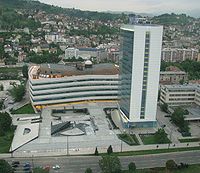
Bosnia and Herzegovina has several levels of political structuring, according to the Dayton accord. The most important of these levels is the division of the country into two entities: Republika Srpska and the Federation of Bosnia and Herzegovina. The Federation of Bosnia and Herzegovina covers 51% of Bosnia and Herzegovina's total area, while Republika Srpska covers 49%. The entities, based largely on the territories held by the two warring sides at the time, were formally established by the Dayton peace agreement in 1995 because of the tremendous changes in Bosnia and Herzegovina's ethnic structure. Since 1996 the power of the entities relative to the State government has decreased significantly. Nonetheless, entities still have numerous powers to themselves. The Brčko District in the north of the country was created in 2000 out of land from both entities. It officially belongs to both, but is governed by neither, and functions under a decentralized system of local government. The Brčko District has been praised for maintaining a multiethnic population and a level of prosperity significantly above the national average.
The third level of Bosnia and Herzegovina's political subdivision is manifested in cantons. They are unique to the Federation of Bosnia and Herzegovina entity, which consists of ten of them. All of them have their own cantonal government, which is under the law of the Federation as a whole. Some cantons are ethnically mixed and have special laws implemented to ensure the equality of all constituent people.
The fourth level of political division in Bosnia and Herzegovina is the municipalities. The Federation of Bosnia and Herzegovina is divided in 74 municipalities, and Republika Srpska in 63. Municipalities also have their own local government, and are typically based on the most significant city or place in their territory. As such, many municipalities have a long tradition and history with their present boundaries. Some others, however, were only created following the recent war after traditional municipalities were split by the Inter-Entity Boundary Line. Each canton in the Federation of Bosnia and Herzegovina consists of several municipalities, which are divided into local communities.
Besides entities, cantons, and municipalities, Bosnia and Herzegovina also has four "official" cities. These are: Banja Luka, Mostar, Sarajevo, and East Sarajevo. The territory and government of the cities of Banja Luka and Mostar corresponds to the municipalities of the same name, while the cities of Sarajevo and East Sarajevo officially consist of several municipalities. Cities have their own city government whose power is in between that of the municipalities and cantons (or the entity, in the case of Republika Srpska).
As a result of the Dayton Accords, the civilian peace implementation is supervised by the High Representative for Bosnia and Herzegovina selected by the Peace Implementation Council. The High Representative has many governmental and legislative powers, including the dismissal of elected and non-elected officials. More recently, several central institutions have been established (such as defense ministry, security ministry, state court, indirect taxation service and so on) in the process of transferring part of the jurisdiction from the entities to the state.
The representation of the government of Bosnia and Herzegovina is by elites who represent the country's three major groups, with each having a guaranteed share of power.
The Chair of the Presidency of Bosnia and Herzegovina rotates among three members ( Bosniak, Serb, Croat), each elected as the Chair for an eight-month term within their four-year term as a member. The three members of the Presidency are elected directly by the people with Federation voters voting for the Bosniak and the Croat, and the Republika Srpska voters for the Serb.
The Chair of the Council of Ministers is nominated by the Presidency and approved by the House of Representatives. He or she is then responsible for appointing a Foreign Minister, Minister of Foreign Trade, and others as appropriate.
The Parliamentary Assembly is the lawmaking body in Bosnia and Herzegovina. It consists of two houses: the House of Peoples and the House of Representatives. The House of Peoples has 15 delegates, two-thirds of which come from the Federation (5 Croat and 5 Bosniaks) and one-third from the Republika Srpska (5 Serbs). The House of Representatives is composed of 42 Members, two-thirds elected from the Federation and one-third elected from the Republika Srpska.
The Constitutional Court of Bosnia and Herzegovina is the supreme, final arbiter of legal matters. It is composed of nine members: four members are selected by the House of Representatives of the Federation, two by the Assembly of the Republika Srpska, and three by the President of the European Court of Human Rights after consultation with the Presidency.
However, the highest political authority in the country is the High Representative in Bosnia and Herzegovina, the chief executive officer for the international civilian presence in the country. Since 1995, the High Representative has been able to bypass the elected parliamentary assembly, and since 1997 has been able to remove elected officials. The methods selected by the High Representative have been criticized as undemocratic. International supervision is to end when the country is deemed politically and democratically stable and self-sustaining.
Military
The Armed Forces of Bosnia and Herzegovina were unified into a single entity in 2005, with the merger of the Army of the Federation of Bosnia and Herzegovina and the Army of Republika Srpska, which had defended their respective regions. The Ministry of Defense had been founded in 2004.
The Bosnian military consists of the Bosnian Ground Forces and Air Force and Air Defense. The Ground Forces number 10,000 active and 5,000 reserve personnel. They are armed with a mix of American, Yugoslavian, Soviet, and European-made weaponry, vehicles, and military equipment. The Air Force and Air Defense Forces has 2,500 personnel and about 45 aircraft. All of its aircraft are utility helicopters and basic trainers. The Air Defense Forces operate MANPAD hand-held missiles, surface-to-air missile (SAM) batteries, anti-aircraft cannons, and radar. Almost all of its anti-aircraft equipment is of Soviet origin, though it also operates some U.S. and Swedish hardware.
Foreign relations
EU integration is one of the main political objectives of Bosnia and Herzegovina; it initiated the Stabilisation and Association Process in 2007. Countries participating in the SAP have been offered the possibility to become, once they fulfill the necessary conditions, Member States of the EU. Bosnia and Herzegovina is therefore a potential candidate country for EU accession. The implementation of the Dayton Accords of 1995 has focused the efforts of policymakers in Bosnia and Herzegovina, as well as the international community, on regional stabilization in the countries-successors of the former Yugoslavia. Within Bosnia and Herzegovina, relations with its neighbors of Croatia, Serbia and Montenegro have been fairly stable since the signing of the Dayton Agreement in 1995.
On April 23, 2010, Bosnia and Herzegovina received the Membership Action Plan from NATO, which is the last step before full membership in the alliance. Full membership is expected in 2014 or 2015, depending on the progress of reforms.
Demographics
Bosnia and Herzegovina is home to three ethnic " constituent peoples": Bosniaks, Serbs and Croats. According to the 1991 census, Bosnia and Herzegovina had a population of 4,377,000, while the 1996 UNHCR unofficial census showed a decrease to 3,920,000. Large population migrations during the Yugoslav wars in the 1990s have caused demographic shifts in the country. No census has been taken since 1991/96, and political disagreements have made it impossible to organize one. Nevertheless, a census has been planned for 2012., but that date has been delayed until 2013. As almost all of the post-war data is simply an estimate, a census would be a statistical, inclusive, and objective way to analyze the demographics of Bosnia and Herzegovina. Most sources, however, estimate the population to be about four million, representing a decrease of 500,000 since 1991. The last official estimate by BHAS (Agency for Statistics of BiH) for 2011 shows a decrease of the population to 3,148,000. Other BHAS estimation of population done on 30 June 2009 is 3,227,000.
Ethnically, according to data from 2000 cited by the Central Intelligence Agency, Bosniak constitute 48% of the population, Serbs 37.1%, Croats 14.3%, and others 0.6%, including Muslim, Jews, Roma, and Albanians. According to unofficial estimates from the Bosnian State Statistics Agency cited by the US Department of State in 2008, 46 percent of the population identify religiously as Muslim, 36 percent as Serb Orthodox, 14 percent as Roman Catholic, 1 percent as Protestant, and 3 percent other (mostly atheists, Jews, and others). Bosnian, Croatian and Serbian are official languages, but all three are mutually intelligible standards of Serbo-Croatian.
| Largest cities or towns of Bosnia and Herzegovina 2012 estimate |
|||||||||
|---|---|---|---|---|---|---|---|---|---|
| Rank | City name | Division | Pop. | Rank | City name | Division | Pop. | ||
 Sarajevo |
1 | Sarajevo | Federation of Bosnia and Herzegovina | 300,855 | 11 | Kasindo | Republika Srpska | 28,443 |  Tuzla |
| 2 | Banja Luka | Republika Srpska | 238,353 | 12 | Trebinje | Republika Srpska | 26,781 | ||
| 3 | Tuzla | Federation of Bosnia and Herzegovina | 99,543 | 13 | Derventa | Republika Srpska | 26,604 | ||
| 4 | Zenica | Federation of Bosnia and Herzegovina | 93,233 | 14 | Zvornik | Republika Srpska | 24,165 | ||
| 5 | Bijeljina | Republika Srpska | 78,960 | 15 | Gradiška | Republika Srpska | 23,256 | ||
| 6 | Mostar | Federation of Bosnia and Herzegovina | 68,392 | 16 | Šamac | Republika Srpska | 22,936 | ||
| 7 | Prijedor | Republika Srpska | 43,307 | 17 | Novi Grad | Republika Srpska | 22,058 | ||
| 8 | Brčko | Brčko District | 38,968 | 18 | Milići | Republika Srpska | 20,136 | ||
| 9 | Bihać | Federation of Bosnia and Herzegovina | 37,511 | 19 | Sanski Most | Federation of Bosnia and Herzegovina | 19,060 | ||
| 10 | Doboj | Republika Srpska | 31,794 | 20 | Bugojno | Federation of Bosnia and Herzegovina | 19,044 | ||
Economy
Bosnia faces the dual-problem of rebuilding a war-torn country and introducing market reforms to its formerly centrally planned economy. One legacy of the previous era is a greatly overstaffed military industry; under former leader Josip Broz Tito, military industries were promoted in the republic, resulting in the development of a large share of Yugoslavia's defense plants but fewer commercially-viable firms.
For the most of Bosnia's history, agriculture has been based on small and inefficient privately owned farms; food has traditionally been a net import for the republic.
The war in the 1990s caused a dramatic change in the Bosnian economy. GDP fell by 75% and the destruction of physical infrastructure devastated the economy. While much of the production capacity has been restored, the Bosnian economy still faces considerable difficulties. Figures show GDP and per capita income increased 10% from 2003 to 2004; this and Bosnia's shrinking national debt being positive trends, but high unemployment and a large trade deficit remain cause for concern.
The national currency is the (Euro-pegged) Convertible Mark (KM), controlled by the currency board. Annual inflation is the lowest relative to other countries in the region at 1.9% in 2004. The international debt was $3.1 billion (2005 est) – the smallest amount of debt owed of all the former Yugoslav republics. Real GDP growth rate was 5% for 2004 according to the Bosnian Central Bank of BiH and Statistical Office of Bosnia and Herzegovina.
Bosnia and Herzegovina has one of the highest income equality rankings in the world, ranking eighth out of 193 nations.
According to Eurostat data, Bosnia and Herzegovina's PPS GDP per capita stood at 29 per cent of the EU average in 2010.
The International Monetary Fund (IMF) announced a loan to Bosnia worth $500 million to be delivered by Stand-By Arrangement. This is scheduled to be approved in September 2012.
Overall value of foreign direct investment (1999–2008):
- 1999: €166 million
- 2000: €159 million
- 2001: €133 million
- 2002: €282 million
- 2003: €338 million
- 2004: €534 million
- 2005: €421 million
- 2006: €556 million
- 2007: €1.628 billion
- 2008: €1.083 billion
From 1994 to 2008, €5.3 billion were invested in the country.
The top investor countries (1994–2007):
- Austria (€1,294 million)
- Serbia (€773 million)
- Croatia (€434 million)
- Slovenia (€427 million)
- Switzerland (€337 million)
- Germany (€270 million)
- Italy (€94.29 million)
- Netherlands (€63.52 million)
- United Arab Emirates (€56.70 million)
- Turkey (€54.81 million)
- All Other Countries (€892.54 million)
Foreign investments by sector for (1994–2007):
- 37.7% Manufacturing
- 21% Banking
- 4.9% Services
- 9.6% Trade
- 0.30% Transport
- 1% Tourism
The United States Embassy in Sarajevo, Bosnia and Herzegovina produces the Country Commercial Guide – an annual report that delivers a comprehensive look at Bosnia and Herzegovina’s commercial and economic environment, using economic, political, and market analysis. It can be viewed on Embassy Sarajevo’s website.
Transport
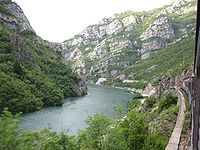
Sarajevo International Airport ( IATA: SJJ, ICAO: LQSA), also known as Butmir Airport, is the main international airport in Bosnia and Herzegovina, located 3.3 NM (6.1 km; 3.8 mi) southwest of the railway station in the capital city of Sarajevo in the suburb of Butmir.
Railway operations in Bosnia and Herzegovina are successors of the Yugoslav Railways within the country boundaries following independence from the Former Yugoslavia in 1992.
Communications
The Bosnian communications market was fully liberalised in January 2006. There are three landline telephone providers, although each one predominantly serves a partile services are provided by three operators, with nationwide services. Mobile data services are also available, including high-speed EDGE and 3G services.
Oslobođenje (Liberation), founded in 1943, is one of the country's longest running continuously circulating newspapers. There are many national publications, only some of which include the Dnevni Avaz (Daily Voice), founded in 1995, and Jutarnje Novine (Morning News) in circulation in Sarajevo. Other local periodicals include the Croatian newspaper Hrvatska riječ and the Bosnian magazine Start, as well as the weekly newspapers Slobodna Bosna (Free Bosnia) and BH Dani (BH Days). Novi Plamen, a monthly magazine, is the most left-wing publication currently. The international news station Al Jazeera maintains a sister channel that caters to the Balkan region, Al Jazeera Balkans, broadcasting out of and based in Sarajevo.
Additionally, the country is the most liberated in terms of freedom of the press in the region, ranking 43rd internationally.
Tourism
According to an estimation of the World Tourism Organization, Bosnia and Herzegovina will have the third highest tourism growth rate in the world between 1995 and 2020.
In 2006, when ranking the best cities in the world, Lonely Planet placed Sarajevo, the national capital and host of the 1984 Winter Olympic Games, as #43, ahead of Dubrovnik at #59, Ljubljana at #84, Bled at #90, Belgrade at #113, and Zagreb at #135.
Tourism in Sarajevo is chiefly focused on historical, religious, and cultural aspects. Bosnia has also become an increasingly popular skiing and Ecotourism destination. In 2010, Lonely Planet's "Best In Travel" nominated it as one of the top ten cities to visit that year. Sarajevo also won travel blog Foxnomad's "Best City to Visit" competition in 2012, beating more than one hundred other cities around the entire world.
Međugorje has become one of the most popular pilgrimage sites for Christians in the world and has turned into Europe's third most important religious place, where each year more than 1 million people visit. It has been estimated that 30 million pilgrims have come to Međugorje since the reputed apparitions began in 1981.
Bosnia and Herzegovina remains one of the last undiscovered natural regions of the southern area of the Alps, with vast tracks of wild and untouched nature attracting adventurers and nature lovers. National Geographic magazine named Bosnia and Herzegovina as the best mountain biking adventure destination for 2012. The central Bosnian Dinaric Alps are favored by hikers and mountaineers, containing both Mediterreanean and Alpine climates. Whitewater rafting is somewhat of a national pastime, with three rivers, including the deepest river canyon in Europe, the Tara River Canyon.
Most recently, The Huffington Post named Bosnia and Herzegovina the "9th Greatest Adventure in the World for 2013", adding that the country boasts "the cleanest water and air in Europe; the greatest untouched forests; and the most wildlife. The best way to experience is the three rivers trip, which purls through the best the Balkans have to offer."
Tourist attractions
Some of the tourist attractions in Bosnia and Herzegovina include:
- Sarajevo, the "Olympic City" or "European Jerusalem"; the scientific, cultural, tourist and commercial centre of Bosnia and Herzegovina.
- Shrine of Our Lady of Međugorje, with Annual Youth Festival; the site of a Marian apparition and susequent Catholic pilgrimage destination.
- Mostar, the "City on Neretva" or "City of Sunshine"; the location of the UNESCO World Heritage Sites of Stari most and old-town Mostar.
- Srebrenica, where the worst war crimes committed in Europe since World War II occurred; features natural beauty, rafting and boat-rides along on the Drina river to Višegrad via the second-deepest canyon in Europe.
- Višegrad, location of the UNESCO World Heritage Site of the Mehmed Paša Sokolović Bridge.
- Banja Luka, the "Green City", with sights such as the Kastel fortress and Ferhadija mosque.
- Bihać and the wateralls of the river Una within Una National Park.
- Jajce, city of the Bosnian kings and the place where Yugoslavia was founded.
- Prijedor, featuring its Old City Mosque, Kozara National Park and, at Mrakovica, Bosnia's largest World War II monument.
- The salt-lakes of Tuzla, birthplace of Meša Selimović.
- The Neretva river and the Rakitnica river canyons in Upper Neretva.
- The Trebižat river and its waterfalls at Kravice and Kočuša.
- The Buna with its spring and historic town of Blagaj.
- The Lower Tara river canyon, the deepest canyon in Europe.
- Sutjeska National Park, featuring the ancient forest of Perućica (one of the last two remaining primeval forests in Europe) and the Sutjeska river canyon.
- Počitelj historical village.
- Mount Bjelašnica and Jahorina, sites used during XIV Olympic Winter Games in 1984.
- The coastal city of Neum.
- Doboj and its 13th century fortress.
- Stolac, featuring the Begovina neighbourhood and Radimlja tombstones.
- Visoko, city of the Bosnian nobility and monarchy, historical capital of the Kingdom of Bosnia and the site of the alleged Bosnian pyramids;
- Tešanj, one of Bosnia's oldest known cities.
- Bijeljina, known for its agriculture and ethnic village Stanišić.
- Lukavac, featuring Modrac Lake (Jezero Modrac), the largest artificial lake in Bosnia and Herzegovina.
- Travnik, the birthplace of Ivo Andrić and once the capital city of the Bosnia Eyalet.
- Ostrožac Castle, a 16th-century castle built by the Ottoman Empire and later expanded by the House of Habsburg.
- Gornji Vakuf
- Konjic, featuring Tito's underground nuclear bunker.
Education
Higher education has a long and rich tradition in Bosnia and Herzegovina. The first bespoke higher-education institution was a school of Sufi philosophy established by Gazi Husrev-beg in 1531. Numerous other religious schools then followed. In 1887, under the Austro-Hungarian Empire, a Sharia law school began a five-year program. In the 1940s the University of Sarajevo became the city's first secular higher education institute. In the 1950s post-bachelaurate graduate degrees became available. Severely damaged during the war, it was recently rebuilt in partnership with more than 40 other universities. There are various other institutions of higher education, including: University "Džemal Bijedić" of Mostar, University of Banja Luka, University of Mostar, University of East Sarajevo, University of Tuzla, American University in Bosnia and Herzegovina and the Academy of Sciences and Arts of Bosnia and Herzegovina, which is held in high regard as one of the most prestigious creative arts academies in the region.
Also, Bosnia and Herzegovina is home to several private and international higher education institutions, some of which are:
- Sarajevo School of Science and Technology
- International University of Sarajevo
- American University in Bosnia and Herzegovina
- Sarajevo Graduate School of Business
- International Burch University
Primary schooling lasts for nine years. Secondary education is provided by general and technical secondary schools (typically Gymnasiums where studies typically last for four years. All forms of secondary schooling include an element of vocational training. Pupils graduating from general secondary schools obtain the Matura and can enroll in any tertiary educational institution or academy by passing a qualification examination prescribed by the governing body or institution. Students graduating technical subjects obtain a Diploma.



![Location of Bosnia and Herzegovina (green)in Europe (dark grey) — [Legend]](../../images/2085/208503.png)
